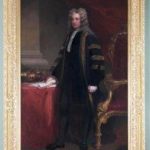William Conolly (1662-1729)
William Conolly was born in Ballyshannon in Co Donegal in 1662. He has been described variously as the son of an innkeeper, a miller or a land manager. He was a Protestant himself but his background was Catholic on his mother side, the Coans, and most probably on his father’s side. In 1717, when William Conolly was appointed as a Lord Justice, Sir John St Leger remarked snidely that ‘many people here especially our quality and old gentry are much offended at Mr Conolly’s being one of them; this gentleman was lately an attorney, his father keeping an ale house in the North of Ireland, this being ‘too notorious to be stifled’.
The son of the innkeeper had the last laugh. By the time of Williams’s death he was the most powerful politician and the wealthiest man in Ireland. The Latin inscription on his funerary monument in the church at Tea Lane, Celbridge gives a short synopsis of his political career. When translated it says that he was Commissioner of the Revenue in the reign of Queen Anne and George I, Privy councillor in the reign of George II, twice elected Speaker of the House of Commons in Ireland and ten times held the Office of Lord Justice of Ireland.
Alongside his political success he also amassed the largest personal fortune in Ireland, with an estimated 150,000 acres creating a rent roll of £17,000 annually. He was the single biggest purchaser of forfeited estates after the Williamite Wars, when James II was defeated. From 1703 onwards he concentrated on the northwest of Ireland for political reasons and the area around Dublin for personal and political prestige.
The Castletown estate of 1,890 acres was purchased in 1709 from Colonel Thomas Dongan for £15,000. In 1725 he added 439 acres at Killadoon and in 1728 he purchased Leixlip Manor, which included the town but not the castle. Conolly had established himself in Kildare. He began to entertain and conduct government business in the existing house at Castletown, described in the deed of purchase as ‘a very good dwelling house, with gardens of pleasure, a good kitchen garden and good orchard, a fine wood and hopyard’.
His advantageous marriage in 1694 to Katherine Conyngham, daughter of Sir Albert Conyngham, was crucial to his success. She brought important connections, her sister was married to the Irish accountant general James Bonnell and her brother Henry Conyngham had excellent political connections including the banker William Cairns and rising political stars Alan and Thomas Broderick. She also brought £2,300 of a dowry, a direct manner, strong personality and valuable political skills. They were a powerful couple socially, politically, and financially.
Work commenced on Castletown House in 1722. It was an odd decision to build as the Conolly’s were in their sixties at that point and had no children. But Castletown was not built to be a family home, its purpose was to entertain and impress. Castletown was more impressive than the vice regal residences at Dublin Castle or Chapelizod. The house was to be their legacy, a physical manifestation of their social, political and financial power.
In his will, written 12 days before his death in 1729, William Conolly made the decision to be buried in Celbridge. He didn’t chose his hometown and political stronghold in Donegal. He didn’t choose Dublin where he had a large residence on Capel Street and where his political career had thrived. He choose Celbridge, forever entwining the Conolly name and Castletown.
After his death on 30th October 1729 Katherine organised ‘the finest funeral that has been seen in this kingdom in many years’. The reception room and staircase of the house in Capel Street were draped with black fabric. Sixty seven poor men dressed in black walked in front of the coffin, one for each year of his life. 700 mourners walked with the coffin from Capel Street to Arran Quay on foot, many then travelling to Celbridge. The funeral was larger and more elaborate than that of Archbishop King who died the same year. Katherine was determined that William Conolly would be respected in death.
William left money in his will for a chartered school for forty orphans or poor children and Katherine built it as requested. Today it is the Celbridge Manor hotel. In 1736 an elaborate heraldic funerary monument was completed in Tea Lane church with life size marble statues of Katherine and William. It was so large that the church had to be extended to accommodate it. In the 1740’s Katherine completed the obelisk known as Conolly’s folly and the building now known as the Wonderful barn. Castletown House, the funerary monument, the charter school, the folly and the barn are today physical reminders of William Conolly, the self-made man who built an enduring legacy, the Conolly’s of Castletown.
Celine Hanratty
Further Reading:
The Making of the Irish Protestant Ascendancy: The Life of William Conolly, 1662-1729 by Patrick Walsh
Elite Women in Ascendancy Ireland, 1690-1745: Imitation and Innovation by Rachel Wilson
Grave Matters: Death and Dying in Dublin, 1500 to the Present, edited by Lisa Marie Griffith and Ciarán Wallace. It contains a chapter ‘Politics, patriotism, and posterity: the funeral of William Conolly in 1729’ by Patrick Walsh.

